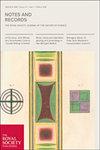The FRS nomination of Sir Prafulla C. Ray and the correspondence of N. R. Dhar
IF 0.6
3区 哲学
Q3 HISTORY & PHILOSOPHY OF SCIENCE
Notes and Records-The Royal Society Journal of the History of Science
Pub Date : 2017-09-13
DOI:10.1098/rsnr.2017.0030
引用次数: 4
Abstract
Sir Prafulla Chandra Ray (1861–1944) was the first Indian chemist to achieve high international reputation. Originally trained at the University of Edinburgh, he worked for many years at Presidency College in Calcutta and then at Calcutta University. He built up a remarkable school of chemical research by attracting many outstanding students to work with him and published about 150 papers—many of them in leading British and German journals. Ray was highly respected by his British peers and was the first Indian of that era to be nominated for FRS, in 1913. At the time when his nomination was being considered by the Royal Society, Ray's favourite student, Nil Ratan Dhar (1892–1986), who was to become the second Indian chemist to achieve high international reputation, worked in London and Paris for a few years. Even when Dhar was merely a 24-year-old student, he lobbied with several leading British chemists for the election of Ray and kept Ray informed in a series of fascinating letters—giving us a rare glimpse of what election to the Royal Society meant for Indian scientists of that era. During this time, Ray received a knighthood for his contributions to chemistry, and Nature published a front-page article on Ray's ‘life-work’. Many British chemists felt strongly that Ray should be elected FRS and were willing to discuss Ray's case with the young Dhar quite openly. But, rather mysteriously, Ray never got elected.Prafulla C.Ray爵士的FRS提名和N.R.Dhar的信件
Prafulla Chandra Ray爵士(1861-1944)是第一位在国际上享有盛誉的印度化学家。他最初在爱丁堡大学接受培训,曾在加尔各答总统学院和加尔各答大学工作多年。他吸引了许多优秀的学生与他合作,建立了一所杰出的化学研究学院,并发表了大约150篇论文,其中许多发表在英国和德国的主要期刊上。雷深受英国同行的尊敬,1913年,他是那个时代第一位获得FRS提名的印度人。在皇家学会考虑他的提名时,雷最喜欢的学生尼尔·拉坦·达尔(1892-1986)在伦敦和巴黎工作了几年,他将成为第二位获得高度国际声誉的印度化学家。即使达尔还是一名24岁的学生,他也曾与几位英国顶尖化学家游说雷的当选,并在一系列引人入胜的信件中向雷通报情况——这让我们罕见地看到了当选皇家学会对那个时代的印度科学家意味着什么。在此期间,雷因其对化学的贡献而获得爵士头衔,《自然》杂志在头版发表了一篇关于雷“生平工作”的文章。许多英国化学家强烈认为雷应该当选FRS,并愿意与年轻的达尔公开讨论雷的案件。但是,相当神秘的是,雷从未当选。
本文章由计算机程序翻译,如有差异,请以英文原文为准。
求助全文
约1分钟内获得全文
求助全文
来源期刊
CiteScore
1.50
自引率
0.00%
发文量
45
审稿时长
>12 weeks
期刊介绍:
Notes and Records is an international journal which publishes original research in the history of science, technology and medicine.
In addition to publishing peer-reviewed research articles in all areas of the history of science, technology and medicine, Notes and Records welcomes other forms of contribution including: research notes elucidating recent archival discoveries (in the collections of the Royal Society and elsewhere); news of research projects and online and other resources of interest to historians; essay reviews, on material relating primarily to the history of the Royal Society; and recollections or autobiographical accounts written by Fellows and others recording important moments in science from the recent past.

 求助内容:
求助内容: 应助结果提醒方式:
应助结果提醒方式:


